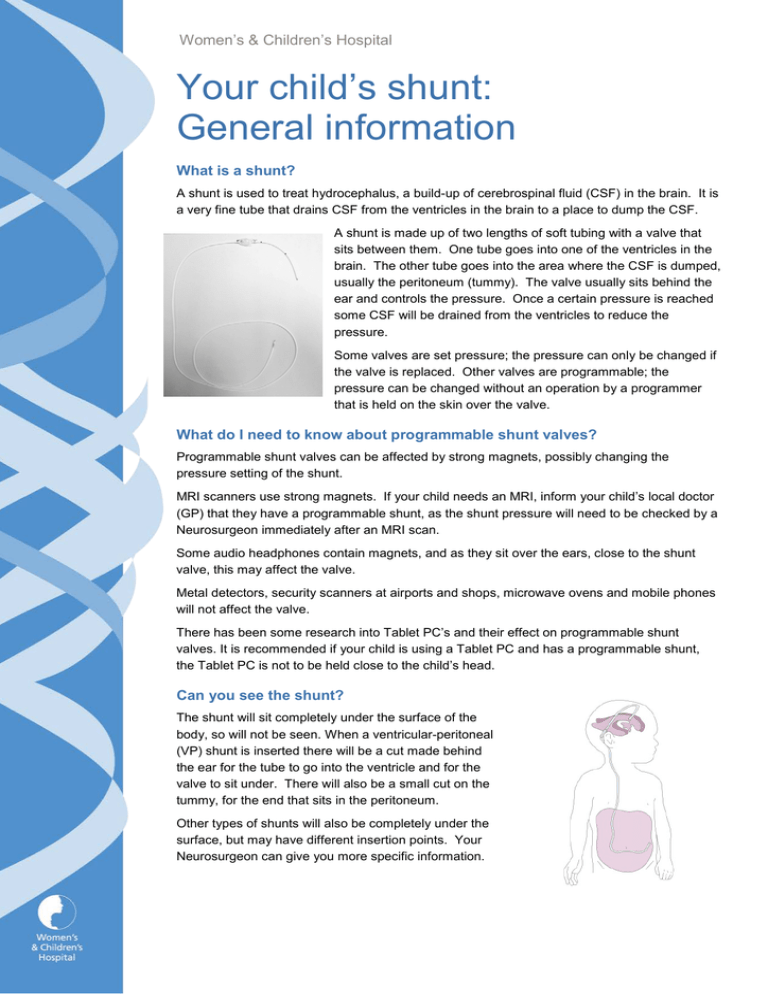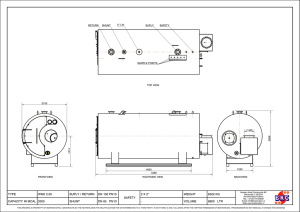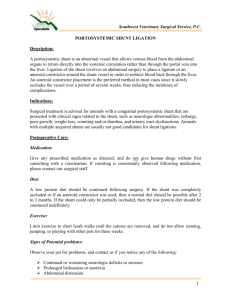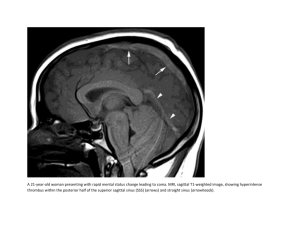
Women’s & Children’s Hospital
Your child’s shunt:
General information
What is a shunt?
A shunt is used to treat hydrocephalus, a build-up of cerebrospinal fluid (CSF) in the brain. It is
a very fine tube that drains CSF from the ventricles in the brain to a place to dump the CSF.
A shunt is made up of two lengths of soft tubing with a valve that
sits between them. One tube goes into one of the ventricles in the
brain. The other tube goes into the area where the CSF is dumped,
usually the peritoneum (tummy). The valve usually sits behind the
ear and controls the pressure. Once a certain pressure is reached
some CSF will be drained from the ventricles to reduce the
pressure.
Some valves are set pressure; the pressure can only be changed if
the valve is replaced. Other valves are programmable; the
pressure can be changed without an operation by a programmer
that is held on the skin over the valve.
What do I need to know about programmable shunt valves?
Programmable shunt valves can be affected by strong magnets, possibly changing the
pressure setting of the shunt.
MRI scanners use strong magnets. If your child needs an MRI, inform your child’s local doctor
(GP) that they have a programmable shunt, as the shunt pressure will need to be checked by a
Neurosurgeon immediately after an MRI scan.
Some audio headphones contain magnets, and as they sit over the ears, close to the shunt
valve, this may affect the valve.
Metal detectors, security scanners at airports and shops, microwave ovens and mobile phones
will not affect the valve.
There has been some research into Tablet PC’s and their effect on programmable shunt
valves. It is recommended if your child is using a Tablet PC and has a programmable shunt,
the Tablet PC is not to be held close to the child’s head.
Can you see the shunt?
The shunt will sit completely under the surface of the
body, so will not be seen. When a ventricular-peritoneal
(VP) shunt is inserted there will be a cut made behind
the ear for the tube to go into the ventricle and for the
valve to sit under. There will also be a small cut on the
tummy, for the end that sits in the peritoneum.
Other types of shunts will also be completely under the
surface, but may have different insertion points. Your
Neurosurgeon can give you more specific information.
What can go wrong with the shunt?
Shunts may last for many years without problems, but sometimes a shunt may have problems or complications.
Infection
Infection could develop around the shunt. Your child may have a fever, redness, swelling or discharge from their
wound/s. They may also show one or more signs that the shunt may not be working properly (see table below).
Obstruction (blockage)
The shunt may stop working properly. Sometimes the tubing can kink or break, or the connections can separate.
The tubing or the valve that connects them can become blocked by blood, brain tissue or infection. If any of these
happen your child may show one or more of the signs that the shunt may not be working properly (see table
below).
If the tubing that goes into the peritoneum becomes blocked your child may experience abdominal tenderness or
pain.
These problems will cause the shunt to not work properly and the hydrocephalus will come back. You will need to
watch for any sign that your child shows that the shunt may not be working properly (see table below).
Over drainage
Sometimes the shunt will drain too much fluid. If this happens your child will complain of headaches while sitting
up, which will get better when they’re lying down.
If this happens you need to bring your child into the Women’s and Children’s Hospital Emergency
Department immediately. If you are in a rural or remote area, take your child to the nearest emergency
department.
How do I know if the shunt may not be working properly?
The most important thing is for you to notice if your child isn’t their usual self or if your child shows a sign that the
shunt may not be working properly.
Signs that shunt may not be working (may have one or more):
If your child shows one or more signs that the shunt is not working properly or may be infected then you
need to bring your child into the Women’s and Children’s Hospital Emergency Department. If you are in a
rural or remote area, take your child to the nearest emergency department.
In an emergency call 000 for an ambulance.
How likely is it that my child will have a seizure (fit)?
A seizure may be a late sign of a shunt not working properly or may be unrelated to the shunt. It is important that
you know the signs and symptoms of a shunt not working properly and get your child to a local doctor (GP) as
soon as possible to help prevent seizures and other complications.
What should I do if my child has a seizure (fit)?
If your child is having a seizure you need to:
• Keep them safe
• Make sure their airway is clear
• Call 000 for an ambulance
• Roll them onto their side when able
• Reassure your child
• Stay with your child until the ambulance is with you.
Do not hold them down or put anything in their mouth.
If your child has had seizures before, your local doctor (GP) may have given you a seizure plan to follow, and you
should follow this plan.
Where can I get support?
There are many support groups for patients, parents, families and friends of children with hydrocephalus:
• The Women’s and Children’s Hospital, Adelaide http://www.wch.sa.gov.au/
• The Women’s and Children’s Hospital, Adelaide, Neurosurgery Department
http://www.wch.sa.gov.au/services/az/divisions/psurg/neuro/index.html
• The Hydrocephalus Support Association: http://www.hydrocephalus.org.au/
• Hydro Kids: https://www.hydro-kids.com/what
• MedicAlert bracelets: https://medalrpx.rtrk.com.au/?utm_source=THEM&utm_medium=cpc&utm_campaign=Search
Other useful factsheets
• Your child and hydrocephalus
• Your child’s shunt: Everyday living for my infant/toddler
• Your child’s shunt: Everyday living for my child/teen
• Your child’s shunt: Frequently Asked Questions
For more information
Women’s and Children’s Hospital
Department of Neurosurgery
72 King William Road
North Adelaide South Australia 5006
Telephone: (08) 81617230
www.wch.sa.gov.au
© Department of Health, Government of South Australia. All rights reserved.






